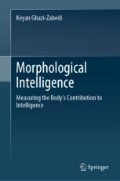Abstract
In this work, we are not focussing only on a formal treatment, but also interested in the applicability of the measures on real data. From this type of analysis, it seems that \(\mathrm {MI}_\mathrm {W}\), so far, is one of the best-suited candidates for applications. This was independently confirmed in previous publications [1-3]. This chapter presents our previous results and discusses them in the context of the recent developments that were presented in the previous chapters.
It doesn’t matter how beautiful your theory is, it doesn’t matter how smart you are. If it doesn’t agree with experiment, it’s wrong
Richard P. Feynman
Access this chapter
Tax calculation will be finalised at checkout
Purchases are for personal use only
References
Zahedi K, Ay N (2013) Quantifying morphological computation. Entropy 15(5):1887–1915
Ghazi-Zahedi K, Haeufle DF, Montufar GF, Schmitt S, Ay N (2016) Evaluating morphological computation in muscle and dc-motor driven models of hopping movements. Front Robot AI 3(42):
Ghazi-Zahedi K, Deimel R, Montúfar G, Wall V, Brock O (2017a) Morphological computation: the good, the bad, and the ugly. In: 2017 IEEE/RSJ international conference on intelligent robots and systems (IROS), pp 464–469
Verl A, Albu-Schäffer A, Brock O, Raatz A (eds) (2015) Soft robotics: transferring theory to application. Springer
Hughes J, Culha U, Giardina F, Guenther F, Rosendo A, Iida F (2016) Soft manipulators and grippers: a review. Front Robot AI 3:69
Deimel R, Brock O (2015) A novel type of compliant and underactuated robotic hand for dexterous grasping. Int J Robot Res 35(1–3):161–185
Martius G, Der R, Ay N (2013) Information driven self-organization of complex robotic behaviors. PLoS ONE 8(5):e63400
van der Maaten L, Hinton G (2008) Visualizing high-dimensional data using t-SNE. J Mach Learn Res 9(85):2579–2605
Tournier M, Nesme M, Gilles B, Faure F (2015) Stable constrained dynamics. ACM Trans Graph 34(4):132:1–132:10
Allard J, Cotin S, Faure F, Bensoussan PJ, Poyer F, Duriez C, Delingette H, Grisoni L (2007) SOFA—an open source framework for medical simulation. Medicine meets virtual reality. Long Beach, California, Etats-Unis, pp 13–18
Deimel R (2017) Soft robotic hands for compliant grasping. PhD thesis, Technische Universität Berlin, Berlin
Clark DD, Sokoloff L (1999) Circulation and energy metabolism of the brain. In: Siegel GJ, Agranoff BW, Albers RW, Fisher SK, Uhler MD (eds) Basic neurochemistry: molecular, cellular and medical aspects, 6th edn, Lippincott-Raven, Philadelphia, chap 31
Sokoloff L, Mangold R, Wechsler R, Kennedy C, Kety S (1955) Effect of mental arithmetic on cerebral circulation and metabolism. J Clin Invest 34(7):1101–1108
Schmitt S, Haeufle DFB (2015) Mechanics and thermodynamics of biological muscle—a simple model approach. In: Verl A, Albu-Schäffer A, Brock O, Raatz A (eds) Soft Robotics, 1st edn. Springer, pp 134–144
van Soest AJ, Bobbert MF (1993) The contribution of muscle properties in the control of explosive movements. Biol Cybern 69(3):195–204
Haeufle DFB, Grimmer S, Kalveram KT, Seyfarth A (2012) Integration of intrinsic muscle properties, feed-forward and feedback signals for generating and stabilizing hopping. J Royal Soc Interface 9(72):1458–1469
Haeufle DFB, Günther M, Wunner G, Schmitt S (2014) Quantifying control effort of biological and technical movements: an information-entropy-based approach. Phys Rev E 89:012716
Ghazi-Zahedi K (2017b) Go implementations of entropy measures. http://github.com/kzahedi/goent
Haeufle DFB, Grimmer S, Seyfarth A (2010) The role of intrinsic muscle properties for stable hopping—stability is achieved by the force-velocity relation. Bioinspiration Biomim 5(1):016004
Frenzel S, Pompe B (2007) Partial mutual information for coupling analysis of multivariate time series. Phys Rev Lett 99:204101
Gerritsen KG, van den Bogert AJ, Hulliger M, Zernicke RF (1998) Intrinsic muscle properties facilitate locomotor control—a computer simulation study. Motor Control 2(3):206–20
John CT, Anderson FC, Higginson JS, Delp SL (2013) Stabilisation of walking by intrinsic muscle properties revealed in a three-dimensional muscle-driven simulation. Comput Methods Biomech Biomed Eng 16(4):451–62
Pinter IJ, Van Soest AJ, Bobbert MF, Smeets JBJ (2012) Conclusions on motor control depend on the type of model used to represent the periphery. Biol Cybern 106(8–9):441–451
Schmitt S, Günther M, Rupp T, Bayer A, Häufle D (2013) Theoretical Hill-type muscle and stability: numerical model and application. Comput Math Methods Med 2013:570878
Dura-Bernal S, Li K, Neymotin SA, Francis JT, Principe JC, Lytton WW (2016) Restoring behavior via inverse neurocontroller in a lesioned cortical spiking model driving a virtual arm. Front Neurosc 10(FEB):1–17
Author information
Authors and Affiliations
Corresponding author
Rights and permissions
Copyright information
© 2019 Springer Nature Switzerland AG
About this chapter
Cite this chapter
Ghazi-Zahedi, K. (2019). Applications. In: Morphological Intelligence. Springer, Cham. https://doi.org/10.1007/978-3-030-20621-5_5
Download citation
DOI: https://doi.org/10.1007/978-3-030-20621-5_5
Published:
Publisher Name: Springer, Cham
Print ISBN: 978-3-030-20620-8
Online ISBN: 978-3-030-20621-5
eBook Packages: Computer ScienceComputer Science (R0)

